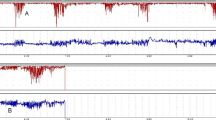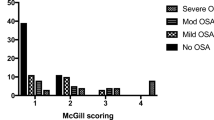Abstract
Nocturnal pulse oximetry has a high positive predictive value for polysomnographically diagnosed obstructive sleep apnoea (OSA) in children. When significant adenotonsillar hypertrophy is diagnosed, adenotonsillectomy (T&A) represents a common treatment for OSA in children. We investigated the role of pulse oximetry in predicting those patients, referred for suspected OSA, who subsequently needed T&A. At-home nocturnal pulse oximetry was performed on 380 children (65.7% males), median age 4.1(IRQ 3.0–5.6) years, referred for suspected OSA, and data were retrospectively analysed. For each recording McGill Oximetry Score (MOS) was categorized. Mean pulse rate (PR) z-score and pulse rate variability (PRV)-corrected (PRSD/meanPR) were significantly higher in children with abnormal MOS. Both parameters were significantly higher in subjects who underwent T&A compared with those not surgically treated. Both DI4 and PRV corrected showed a negative correlation with the elapsed time between pulse oximetry recordings and T&A. The logistic regression model showed a strong effect of an abnormal MOS as a predicting factor for T&A (adjusted odds ratio 19.7).
Conclusions: In our study, children with OSA who subsequently needed T&A showed higher PRV compared to those without surgical indication. Children with abnormal MOS were nearly 20 times more likely to undergo T&A.
What is Known: • Nocturnal pulse oximetry has a high positive predictive value for polysomnographically diagnosed obstructive sleep apnoea in children. • When significant adenotonsillar hypertrophy is diagnosed, adenotonsillectomy represents a common treatment for OSA in children. |
What is New: • An abnormal pulse oximetry highly predict the indication for adenotonsillectomy. • We suggest the use of at-home pulse oximetry as method to predict prescription of adenotonsillectomy, and this may be useful in contexts where polysomnography is not readily available. |
Similar content being viewed by others
Abbreviations
- AHI:
-
Apnea index
- MOS:
-
McGill Oximetry Score
- OSA:
-
Obstructive sleep apnoea
- PR:
-
Pulse rate
- PRV:
-
Pulse rate variability
- PSG:
-
Polysomnography
- T&A:
-
Adenotonsillectomy
References
Aljadeff G, Gozal D, Schechtman VL, Burrell B, Harper RM, Ward SL (1997) Heart rate variability in children with obstructive sleep apnea. Sleep 20:151–157
American Academy of Paediatrics (2002) Clinical practice guideline: diagnosis and management of childhood obstructive sleep apnea syndrome. Pediatrics 109(4):704–712
American Thoracic Society (1996) Standards and indications for cardiopulmonary sleep studies in children. Am J Respir Crit Care Med 153(2):866–878
Baharav A, Kotagal S, Rubin BK, Pratt J, Akselrod S (1999) Autonomic cardiovascular control in children with obstructive sleep apnea. Clin Auton Res 9:345–351
Brouillette RT, Morielli A, Leimanis A, Waters KA, Luciano R, Ducharme FM (2000) Nocturnal pulse oximetry as an abbreviated testing modality for pediatric obstructive sleep apnea. Pediatrics 105(2):405–412
Capdevila OS, Kheirandish-Gozal L, Dayyat E, Gozal D (2008) Pediatric obstructive sleep apnea: complications, management, and long-term outcomes. Proc Am Thorac Soc 5(2):274–282
Constantin E, McGregor CD, Cote V, Brouillette RT (2008) Pulse rate and pulse rate variability decrease after adenotonsillectomy for obstructive sleep apnea. Pediatr Pulmonol 43(5):498–504
Corbo GM, Forastiere F, Agabiti N, Pistelli R, Dell’Orco V, Perucci CA, Valente S (2001) Snoring in 9- to 15-year-old children: risk factors and clinical relevance. Pediatrics 108(5):1149–1154
Foo JY, Bradley AP, Wilson SJ, Williams GR, Dakin C, Cooper DM (2006) Screening of obstructive and central apnoea/hypopnoea in children using variability: a preliminary study. Acta Paediatr 95:561–564
Gozal D (2009) Sleep, sleep disorders and inflammation in children. Sleep Med 10(Suppl 1):S12–S16
Horwood L, Brouillette RT, McGregor CD, Manoukian JJ, Constantin E (2014) Testing for pediatric obstructive sleep apnea when health care resources are rationed. JAMA Otolaryngol Head Neck Surg 140(7):616–623
Kaditis AG, Alonso Alvarez ML, Boudewyns A, Alexopoulos EI, Ersu R, Joosten K, Larramona H, Miano S, Narang I, Trang H, Tsaoussoglou M, Vandenbussche N, Villa MP, Van Waardenburg D, Weber S, Verhulst S (2016) Obstructive sleep disordered breathing in 2- to 18-year-old children: diagnosis and management. Eur Respir J 47:69–94
Khositseth A, Chokechuleekorn J, Kuptanon T, Leejakpai A (2013) Rhythm disturbances in childhood obstructive sleep apnea during apnea-hypopnea episodes. Ann Pediatr Cardiol 6(1):39–42
Kwok KL, Yung TC, Ng DK, Chan CH, Lau WF, Fu YM (2011) Heart rate variability in childhood obstructive sleep apnea. Pediatr Pulmonol 46:205–210
Marcus CL, Brooks LJ, Draper KA, Gozal D, Halbower AC, Jones J, Schechter MS, Sheldon SH, Spruyt K, Ward SD, Lehmann C, Shiffman RN; American Academy of Pediatrics Diagnosis and management of childhood obstructive sleep apnea syndrome. Pediatrics 2012; 130(3):576–584.
Mason DG, Iyer K, Terrill PI, Wilson SJ, Suresh S (2010) Pediatric obstructive sleep apnea assessment using pulse oximetry and dual RIP bands. Conf Proc IEEE Eng Med Biol Soc 2010:6154–6157
Materia E, Baglio G, Bellussi L, Marchisio P, Perletti L, Pallestrini E, Calia V (2005) The clinical and organisational appropriateness of tonsillectomy and adenoidectomy an Italian perspective. Int J Pediatr Otorhinolaryngol 69:497–500
McKenzie SA, Bhattacharya A, Sureshkumar R, Joshi B, Franklin A, Pickering R, Dundas I (2008) Which obese children should have a sleep study? Respir Med 102(11):1581–1585
McNamara F, Issa FG, Sullivan CE (1996) Arousal pattern following central and obstructive breathing abnormalities in infants and children. J Appl Physiol 81:2651–2657
Mograss MA, Ducharme FM, Brouillette RT (1994) Movement/arousals, description, classification, and relationship to sleep apnea in children. Am J Respir Crit Care Med 150:1690–1696
Muzumdar HV, Sin S, Nikova M, Gates G, Kim D, Arens R (2011) Changes in heart rate variability after adenotonsillectomy in children with obstructive sleep apnea. Chest 139(5):1050–1059
Nixon GM, Kermack AS, Davis GM, Manoukian JJ, Brown KA, Brouillette RT (2004) Planning adenotonsillectomy in children with obstructive sleep apnea: the role of overnight oximetry. Pediatrics 113(1 Pt 1):e19–e25
Noehren A, Brockmann PE, Urschitz MS, Sokollik C, Schlaud M, Poets CF (2010) Detection of respiratory events using pulse rate in children with and without obstructive sleep apnea. Pediatr Pulmonol 45(5):459–468
O’Driscoll DM, Foster AL, Ng ML, Yang JSC, Bashir F, Nixon GM, Davey MJ, Anderson V, Walker AM, Trinder J, Horne RSC (2009) Acute cardiovascular changes with obstructive events in children with sleep disordered breathing. Sleep 32:1265–1271
Pavone M, Cutrera R, Verrillo E, Salerno T, Soldini S, Brouillette RT (2013) Night-to-night consistency of at-home nocturnal pulse oximetry testing for obstructive sleep apnea in children. Pediatr Pulmonol 48(8):754–760
Pu Y, Patterson R, Cramerbornemann M (2005) Nocturnal cardiorespiratory indices—a novel screening tool for pediatric obstructive sleep disordered breathing. Conf Proc IEEE Eng Med Biol Soc 3:2575–2578
Saito H, Araki K, Ozawa H, Mizutari K, Inagaki K, Habu N, Yamashita T, Fujii R, Miyazaki S, Ogawa K (2007) Pulse-oximetery is useful in determining the indications for adeno-tonsillectomy in pediatric sleep-disordered breathing. Int J Pediatr Otorhinolaryngology 71(1):1–6
Shouldice RB, O’Brien LM, O’Brien C, de Chazal P, Gozal D, Heneghan C (2004) Detection of obstructive sleep apnea in pediatric subjects using surface lead electrocardiogram features. Sleep 27:784–792
Villa MP, Pietropaoli N, Supino MC, Vitelli O, MD, Rabasco J, Evangelisti M, del Pozzo M, Kaditis AG. Diagnosis of pediatric obstructive sleep apnea syndrome in settings with limited resources. JAMA Otolaryngol Head Neck Surg. 2015; 141(11):990–996.
Author information
Authors and Affiliations
Corresponding author
Ethics declarations
Funding
None.
Conflict of interest
The authors declare that they have no conflict of interest.
Research involving human participants
All procedures performed in studies involving human participants were in accordance with the ethical standards of the institutional and/or national research committee and with the 1964 Helsinki declaration and its later amendments or comparable ethical standards.
Informed consent
The study was approved by the Bambino Gesù Children’s Hospital Scientific Board (Rome, Italy); at the time of each recording, parents signed an informed consent.
Additional information
Communicated by Peter de Winter
Martino Pavone and Nicola Ullmann contributed equally as co-first authors.
Revisions received: 19 December 2016; 04 January 2017
Rights and permissions
About this article
Cite this article
Pavone, M., Ullmann, N., Verrillo, E. et al. At-home pulse oximetry in children undergoing adenotonsillectomy for obstructive sleep apnea. Eur J Pediatr 176, 493–499 (2017). https://doi.org/10.1007/s00431-017-2868-1
Received:
Revised:
Accepted:
Published:
Issue Date:
DOI: https://doi.org/10.1007/s00431-017-2868-1




